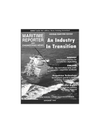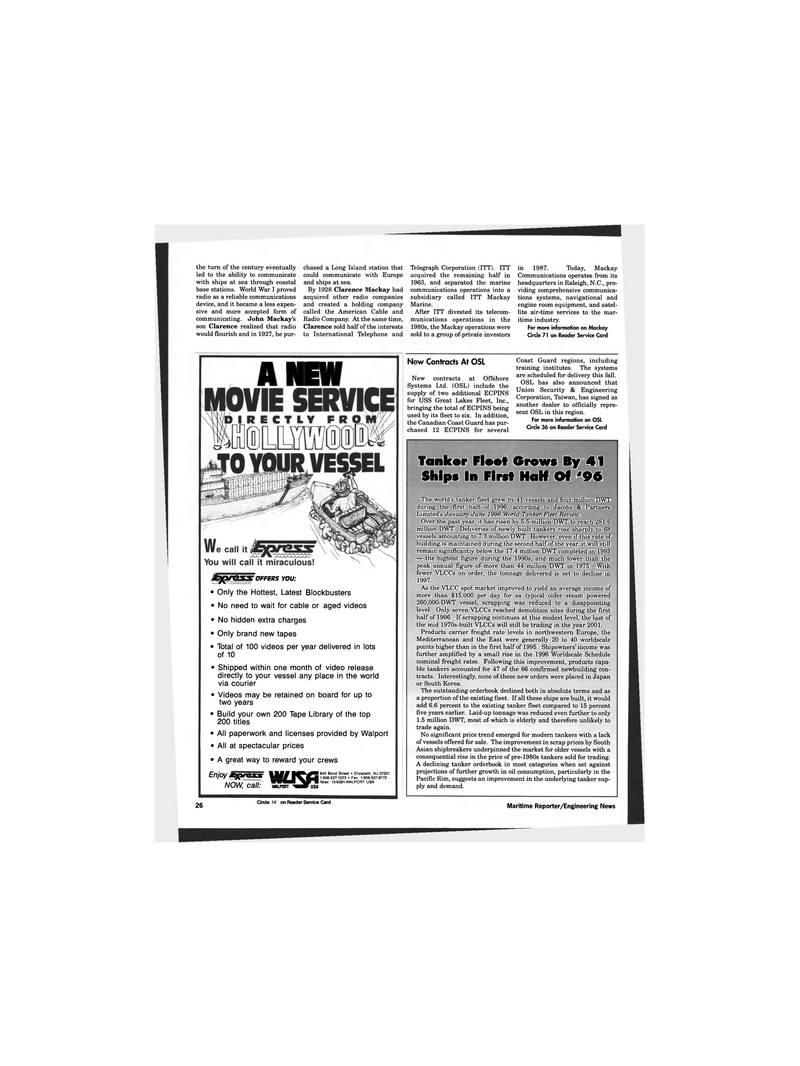
Page 24: of Maritime Reporter Magazine (September 1996)
Read this page in Pdf, Flash or Html5 edition of September 1996 Maritime Reporter Magazine
the turn of the century eventually led to the ability to communicate with ships at sea through coastal base stations. World War I proved radio as a reliable communications device, and it became a less expen- sive and more accepted form of communicating. John Mackay's son Clarence realized that radio would flourish and in 1927, he pur- chased a Long Island station that could communicate with Europe and ships at sea.
By 1928 Clarence Mackay had acquired other radio companies and created a holding company called the American Cable and
Radio Company. At the same time,
Clarence sold half of the interests to International Telephone and
Telegraph Corporation (ITT). ITT acquired the remaining half in 1963, and separated the marine communications operations into a subsidiary called ITT Mackay
Marine.
After ITT divested its telecom- munications operations in the 1980s, the Mackay operations were sold to a group of private investors
New Contracts At OSL
New contracts at Offshore
Systems Ltd. (OSL) include the supply of two additional ECPINS for USS Great Lakes Fleet, Inc., bringing the total of ECPINS being used by its fleet to six. In addition, the Canadian Coast Guard has pur- chased 12 ECPINS for several in 1987. Today, Mackay
Communications operates from its headquarters in Raleigh, N.C., pro- viding comprehensive communica- tions systems, navigational and engine room equipment, and satel- lite air-time services to the mar- itime industry.
For more information on Mackay
Circle 71 on Reader Service Card
Coast Guard regions, including training institutes. The systems are scheduled for delivery this fall.
OSL has also announced that
Union Security & Engineering
Corporation, Taiwan, has signed as another dealer to officially repre- sent OSL in this region.
For more information on OSL
Circle 36 on Reader Service Card
ANEW
M^p/XZSiS OFFERS YOU: • Only the Hottest, Latest Blockbusters • No need to wait for cable or aged videos • No hidden extra charges • Only brand new tapes • Total of 100 videos per year delivered in lots of 10 • Shipped within one month of video release directly to your vessel any place in the world via courier • Videos may be retained on board for up to two years • Build your own 200 Tape Library of the top 200 titles • All paperwork and licenses provided by Walport • All at spectacular prices • A great way to reward your crews
Fninu TkMMW 840 Bond Street • Elizabeth. NJ 07201 1-lljuy A^v<—« MVJ\U 1-908-527-1223 • Fax: 1-908-527-8772 *
Tanker Fleet Grows By 41
Ships In First Half Of '96
The world's tanker fleet grew by 41 vessels and four million DWT during the first half of 1996, according to Jacobs & Partners
Limited's January-June 1996 World Tanker Fleet Review.
Over the past year, it has risen by 5.5 million DWT to reach 281.6 million DWT. Deliveries of newly built tankers rose sharply to 68 vessels amounting to 7.3 million DWT. However, even if this rate of building is maintained during the second half of the year, it will still remain significantly below the 17.4 million DWT completed in 1993 — the highest figure during the 1990s, and much lower than the peak annual figure of more than 44 million DWT in 1975. With fewer VLCCs on order, the tonnage delivered is set to decline in 1997.
As the VLCC spot market improved to yield an average income of more than $15,000 per day for sa typical older steam powered 260,000-DWT vessel, scrapping was reduced to a disappointing level. Only seven VLCCs reached demolition sites during the first half of 1996. If scrapping continues at this modest level, the last of the mid 1970s-built VLCCs will still be trading in the year 2001.
Products carrier freight rate levels in northwestern Europe, the
Mediterranean and the East were generally 20 to 40 worldscale points higher than in the first half of 1995. Shipowners' income was further amplified by a small rise in the 1996 Worldscale Schedule nominal freight rates. Following this improvement, products capa- ble tankers accounted for 47 of the 66 confirmed newbuilding con- tracts. Interestingly, none of these new orders were placed in Japan or South Korea.
The outstanding orderbook declined both in absolute terms and as a proportion of the existing fleet. If all these ships are built, it would add 6.6 percent to the existing tanker fleet compared to 15 percent five years earlier. Laid-up tonnage was reduced even further to only 1.5 million DWT, most of which is elderly and therefore unlikely to trade again.
No significant price trend emerged for modern tankers with a lack of vessels offered for sale. The improvement in scrap prices by South
Asian shipbreakers underpinned the market for older vessels with a consequential rise in the price of pre-1980s tankers sold for trading.
A declining tanker orderbook in most categories when set against projections of further growth in oil consumption, particularly in the
Pacific Rim, suggests an improvement in the underlying tanker sup- ply and demand. 26 Circle 353 on Reader Service Card Maritime Reporter/Engineering News

 23
23

 25
25
